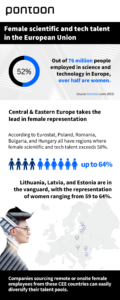Life Sciences and Pharma Segment Burst: Summer 2023
Research
.
In the new volume of Life Sciences and Pharma Segment Burst, we explore the most recent trends in hiring and retaining scientific and healthcare talent.
Female scientific talent thrives in Central and Eastern Europe
 As the European Union continues to bolster its scientific and technological workforce, an encouraging trend has emerged. According to the latest data from Eurostat, over half of the 76 million people employed in science and technology are women.
As the European Union continues to bolster its scientific and technological workforce, an encouraging trend has emerged. According to the latest data from Eurostat, over half of the 76 million people employed in science and technology are women.
In the landscape of science and technology employment, women have made significant strides. However, when considering specific roles like scientists and engineers, the representation drops to 41%. This highlights the persistent gender disparity in certain scientific fields and underscores the need for targeted efforts to foster female talent.
Central and Eastern Europe leads the way
Eurostat’s data reveals that Central and Eastern Europe have emerged as prolific hubs of female scientific and technological talent within the EU. Not only do these regions present attractive destinations for foreign direct investment, but they also offer a treasure trove of skilled female professionals, making these countries valuable sources of talent for various industries.
The Baltic States stand out as beacons of female scientific talent. Lithuania leads the charge, with an impressive 64% representation of women in science and technology. Following closely are Latvia, with 62%, and Estonia, with 59%. These countries have managed to create environments conducive to the growth and development of female professionals in the scientific realm, paving the way for others to follow suit.
Beyond the Baltic States, several other Central and Eastern European countries demonstrate a robust representation of women in science. Poland, Romania, Bulgaria, and Hungary have regions where female talent exceeds 58%. This diversity of countries reflects a broader shift towards inclusivity and gender equality within the EU’s scientific landscape.
Pharmaceutical companies seeking to increase the diversity and representation of women in their workforce should take note of the flourishing female scientific talent in Central and Eastern Europe. Setting up operations in these regions or sourcing remote workers can offer numerous advantages, including access to a rich pool of skilled professionals.
Strategies for retaining healthcare talent
77% of HR leaders in healthcare recognise employee engagement and retention as the most critical issue. However, only half of them believe their organisations are succeeding at employee retention. To address this challenge, companies must adopt a multifaceted approach, focusing on various aspects that resonate with clinicians, who are the backbone of the industry.
Flexibility
Healthcare employers that accommodate flexible schedules are more likely to attract and retain the best talent. Offering options for work-life balance not only enhances job satisfaction but also promotes loyalty among employees, resulting in a stronger, more engaged workforce.
Career progression
Healthcare organisations must provide flexible career paths for their clinicians. Empowering employees with growth opportunities, skill development, and autonomy leads to higher job satisfaction. By demonstrating a commitment to employee development, companies can build long-term relationships with their workforce, mitigating the risk of losing valuable talent.
Permanent employment
Recent trends indicate that an increasing number of clinicians are seeking permanent employment opportunities. 86% of clinicians who have been on long- and short-term travel contracts are more willing to explore permanent employment and 46% are planning to secure permanent positions in 2023. Addressing this preference is crucial for healthcare employers to build a stable, dedicated workforce.
Enhancing the work experience
To improve talent retention, healthcare employers must invest in their workforce. This includes offering competitive salaries, comprehensive benefits packages, retention bonuses, retirement plans, tuition reimbursement, and childcare services. Studies have shown that 100,000 clinicians in the US aged 49 or younger have left the sector due to a lack of affordable childcare and virtual learning for their children.
Healthcare leaders must proactively address talent retention challenges to build robust and thriving organisations. Investing in clinicians not only ensures organisational stability but also fosters a sense of loyalty and dedication that is vital for achieving success in the highly competitive healthcare landscape.
Job trends in the pharmaceutical sector
According to Pharmaceutical Technology’s research, after the previous year’s market slowdown, the start of 2023 saw continued adverse effects on hiring plans due to rising interest rates and hints of recession. This situation led to layoffs at several biotech companies.
At the beginning of the year, there was a decline in hiring for various roles, but recruitment rates have been gradually stabilising since then. Notably, there has been a substantial number of job advertisements for roles requiring sector-specific expertise, such as clinical laboratory technologists and technicians, and biological technicians.
However, the highest number of both active job listings and filled positions in the pharmaceutical industry were for general and operational managers. Registered nurses have also been among the roles heavily advertised within the pharmaceutical space during this period. Overall, the industry appears to be cautiously navigating the hiring landscape amidst economic uncertainties, with some specialised roles and managerial positions in demand.
Job posting related to AI
In the past three months, job postings related to generative AI in the pharmaceutical sector have seen an increase of 407%. This rise is noteworthy as the overall pharmaceutical industry experienced a downturn of 7% in job postings during the same period.
According to Pharmaceutical Technology, although the increase in generative AI job postings is considered an outlier due to the low number of such jobs in previous months – with the total postings still below 100 – it reflects a growing interest in the technology’s potential.
Experts agree that using generative AI trained on big data can considerably shorten the initial exploratory phase in drug design, potentially reducing it by three or four years. This efficiency can translate to significant cost savings in drug development, both in terms of time and money.
Related Post
In the new volume of Life Sciences and Pharma Segment Burst, we explore the most recent trends in the sector.
Female leaders in healthcare
There is no gender equity without health equity. ...





